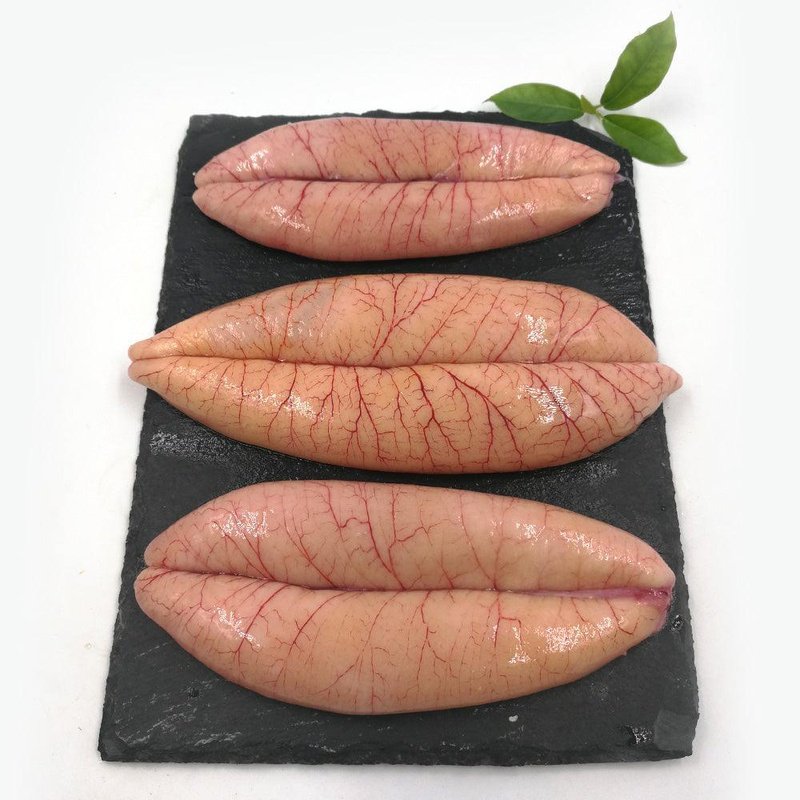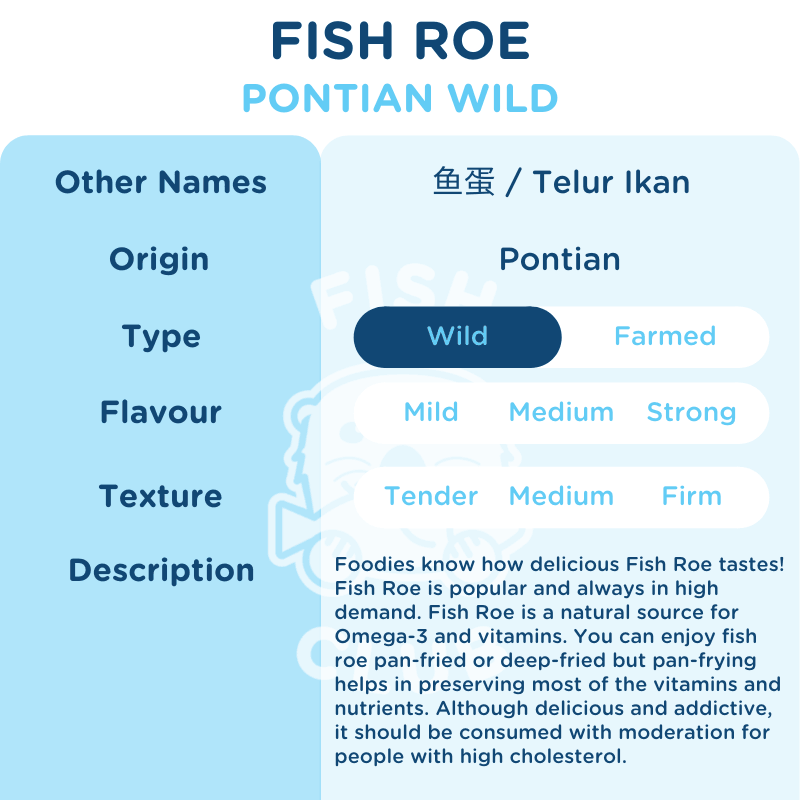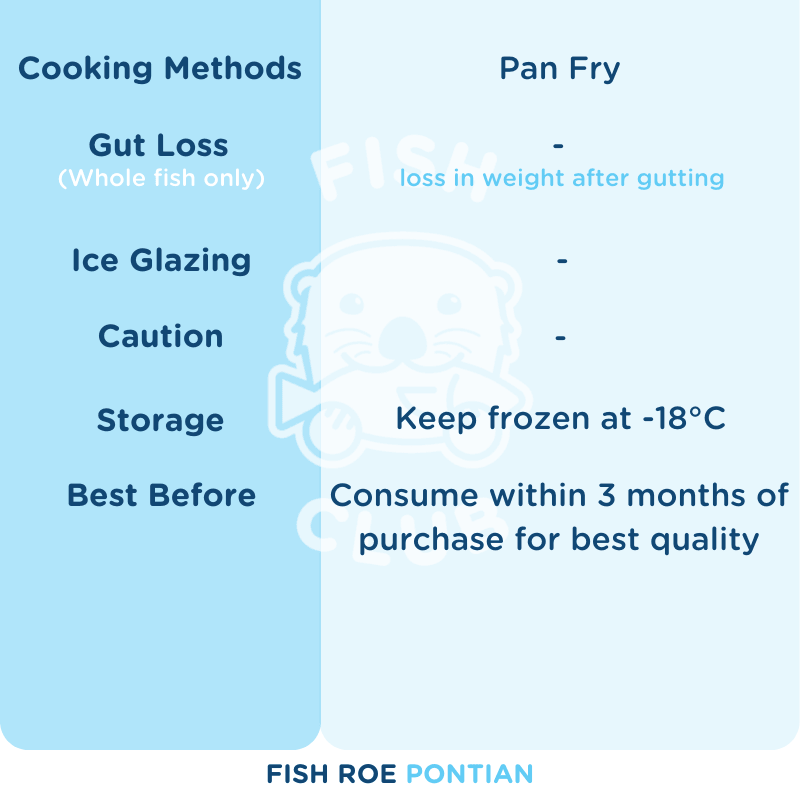Fish Club
Pontian Fish Roe / 鱼蛋
Pontian Fish Roe / 鱼蛋
SKU:PTI-W-200
Origin: Pontian
Out of stock
Couldn't load pickup availability
Fish Roe 鱼蛋
Chinese Name(s): 鱼蛋 Local Name(s): Telur Ikan Origin: Pontian 产地:笨珍 Type: Wild Caught 种类:野生 Flavour: - 口味:- Texture: - 肉质:- Cooking Method: Pan Fry 烹煮方式:煎炸 Weight Loss after cleaning (whole fish): 0% 清理后重量减少(全鱼):0% Caution: Customized cutting is NOT available. 注意:恕不接受客制化切割 Storage: Keep frozen at -18°C. For best quality, consume within 3 months. 储存方式:冷冻雪藏 -18°C。购买后3个月内食用,品质最佳。 ✅ 100% Preservative Free 绝无防腐 ✅ Cleaned & Gutted 去鳞清内脏 ✅ Vacuum Packed 真空包装 ✅ Flash Frozen 急速冷冻 ———————————————————————————————————————— Think of fish eggs, and you might picture a ritzy dinner party somewhere in Manhattan, where the 1% get together and savor their caviar while lamenting how hard it is to find good pilots for their private jets. Caviar isn’t the final word on fish eggs, though, and there are plenty of options that the rest of us can afford. That’s lucky for us, because the benefits of eating them are amazing. Fish eggs, also known as roe, are an incredible food rich in micronutrients and Omega-3 fatty acids. And unlike fermented cod liver oil (the other fish-derived food so nutritious it counts as a supplement), they’re actually tasty, either plain or as an ingredient in all kinds of recipes.Fish Eggs and Nutrition
Roe can come from all different kinds of fish, including the beluga sturgeon (true caviar), other types of sturgeon (the source of a lot of imitation caviar), salmon (the red-orange eggs in sushi), and carp. Some shellfish, like lobsters, also produce edible eggs technically known as coral because of their color. While true roe (or hard roe) only comes from female fish, some markets also offer soft roe, which is the milt, or semen of the male fish. All the different kinds of roe are very nutritious, but salmon and carp roe are much more affordable for most people than fancy caviar. They’re also more environmentally friendly – overfishing has depleted the natural populations of beluga sturgeon so much that it’s actually illegal to import it into the US. Nutritionally, fish eggs share one important benefit with fish oil supplements: they’re very high in anti-inflammatory Omega-3 fats. Since roe is a natural source of these fats, it even beats out a supplement for nutritional quality, since there’s much less risk of the fats oxidizing during processing. Like most real foods, fish eggs also have more than one nutritional benefit. As one of the few food sources of Vitamin D (others include chicken eggs and fatty cold-water fish), roe is a great supplemental food, especially during the winter. Like Omega-3s, Vitamin D is even better from a whole food than from a supplement, since the whole food version contains other vitamins and minerals in an unprocessed form, without any fillers or additives. In fact, the Omega-3 fats and the Vitamin D in roe even work together, because Vitamin D is fat-soluble, so the healthy fats help your body absorb and use it. Roe is also rich in Vitamin B12, one of the most important micronutrients for mental health and brain development. Like other seafood, it contains a substantial amount of selenium, a micronutrient otherwise hard to get, except from Brazil nuts. Magnesium, iron, and even a little bit of calcium round out an already impressive set of nutrition facts. Before humans even had names for these vitamins, people in traditional cultures already knew how powerful roe was. Fish eggs are one of the most potent traditional “superfoods” for fertility, and Weston A. Price observed many cultures going to extreme lengths to feed roe to their pregnant women. Now, even the USDA is recommending that parents include it in their babies’ diets, although they would probably do better to recommend it for everyone.Finding Good Fish Eggs
Since roe isn’t very popular in North America outside of sushi, it can be a challenge to find a good brand. The very best way to ensure the quality and freshness is to get the roe directly from the fish, at an actual fish market. Fresh roe is a seasonal luxury, though, since it’s only available in spring when the fish are spawning. During the rest of the year, and all year round for people who don’t live on the coast, several online retailers provide roe that’s been prepared in various ways (usually salting and curing) to preserve it. If you go this route, make sure you get a product intended for human consumption, since fish eggs are also used as bait and food in aquariums. It’s also possible to get roe at some supermarkets, if you live near a Whole Foods or another high-end chain. Even if the eggs aren’t usually available, check back again around New Year’s, since some stores will stock up on caviar around the holiday party season. Make sure to read the labels carefully: roe in a jar or can is often packaged with a lot of preservatives. Also try checking ethnic grocery stores, especially Asian markets and Mediterranean/Middle Eastern stores.Cooking and Serving Fish Eggs
When cooking any kind of food rich in PUFA (even Omega-3 PUFA), it’s always best to choose a cooking method that won’t destroy the Omega-3s. Being packaged in a whole food, instead of an isolated oil, definitely helps keep the O3s in fish eggs intact. Lower heat is better, but even that isn’t a guarantee. Interestingly enough, some spices seem to help quite a bit: at 150 degrees Celsius (302 degrees Fahrenheit), rosemary and oregano extracts preserved over half of the Omega-3s when added to fish oil during cooking, compared to 15-20% without the oils. If you’re lucky enough to get fresh roe straight from the fish, you can cure it yourself into salmon caviar, with a minimum of fuss and equipment. This method is very gentle on the Omega-3s, since it doesn’t use anything hotter than tap water. Alternately, you could sauté or bake the roe by itself, or even cook it with the fish it came in, for an impressive and nutrient-dense party dish. Pan-fried roe recipes also exist, but these are more suspect, since frying is one of the cooking methods most destructive to the O3 fats. Another easy alternative is to let the roe simmer for a few minutes to cook, and then simply add it to any egg dish or omelet. The salty roe taste is a great addition to the eggs; try garnishing some deviled eggs with a sprinkle of caviar for an extra-fancy party dish. This simple egg soufflé would also be tasty with some roe baked in, and a plain omelet with just roe and eggs is a perfect proof that you don’t need a fancy recipe when you have fresh, high-quality ingredients. For a different kind of preparation, taramosalata is a Greek dip made with fish eggs – it usually incorporates stale bread, but you can just as easily use potatoes or almonds for a Paleo version. It’s almost like fish egg mayonnaise: try it as a soup topping, a vegetable dip, or a snack straight from the spoon. Alternately, an adventurous take on safe starches is this parsnip dish with roe as a topping, flavored with cumin. If you’re getting a pre-prepared package of fish eggs instead of cooking it yourself, roe aficionados claim that it’s best eaten straight out of the jar – grab a spoon and dig in. If a straight spoonful of little eggs grosses you out, you could also try serving them as a “topper” on hard-boiled eggs, crackers, or these Primal blinis, tiny pancakes made with eggs and butter (this also adds even more nutritional value to a food that’s already fantastic in itself). Instead of buying the fish eggs plain, you might also be able to find a traditional Italian preparation called botargo (also spelled bottarga). Botargo is a spread made with cured roe and usually served either plain or on crackers.Enjoy your Fish Eggs!
Seafood and eggs are two of the most nutritious parts of a Paleo diet, so if there’s ever a competition for the ultimate Paleo superfood, fish roe would at least be a strong contender (now if only there were a way to get fish roe liver…). Of course, no one food is the “perfect food” all by itself, but that’s just a reason to prepare these tiny delicacies with other nutrient-dense foods like eggs and butter, dish up some taramosalata with kale chips, or enjoy your roe as an ingredient in Paleo-friendly sushi.How To Make: Fish Roe with Herbs
Ingredients
1/4 cup butter 4 sets rockfish roe Salt and pepper, to taste 2 teaspoons lemon juice 1 tablespoon chopped parsley 2 teaspoons chopped chives 2 teaspoons chopped thymeSteps
In a large, heavy skillet, heat the butter and add the roe. Sprinkle with salt and pepper. Cook the roe on both sides, turning once carefully, about 10 minutes total cooking time. When the roe is lightly browned and cooked through, transfer to a hot platter. Add the remaining ingredients to the skillet. Heat, stirring, and pour over the roe. Serve immediately.Also Try: Fried Fish Roe
Sources https://www.npr.org/templates/story/story.php?storyId=125898335
Additional Information:
Caution: Customized cutting is NOT available.注意:恕不接受客制化切割
Storage: Keep frozen at -18°C. For best quality, consume within 3 months.
储存方式:冷冻雪藏 -18°C。购买后3个月内食用,品质最佳。
✅ 100% Preservative Free 绝无防腐
✅ Cleaned & Gutted 去鳞清内脏
✅ Vacuum Packed 真空包装
✅ Flash Frozen 急速冷冻
How we package your order?
How we package your order?
The vacuum sealed seafood products and frozen chill packs, which contain non-toxic gel are packed in a polystyrene box, so the chill packs distribute the cold evenly throughout your fish and seafood, ensuring maximum freshness.
We seal the polystyrene box with packing tape and hand it to our cold chain logistic to deliver to you.
What should I do when my order arrives?
What should I do when my order arrives?
Remove your seafood products as soon as possible from the box, refrigerate all fresh items and freeze all frozen goods until you are ready to prepare them for consumption.
How is your frozen seafood handled? What is your freezing process?
How is your frozen seafood handled? What is your freezing process?
Our fish and shellfish are processed and immediately frozen in our -45°c blast freezer. No chemicals or preservatives are added during the freezing or production process on any of our seafood items.
What is a -45 Degree Freezer and how does it affect the seafood when defrosted?
What is a -45 Degree Freezer and how does it affect the seafood when defrosted?
Blast freezing seafood products at a lower temperature keeps the wall of the cell intact, ensuring that water from the inside does not exit. When defrosted, the quality, texture, and appearance will remain completely intact just as if it were a fresh product.
What is the proper way to defrost frozen seafood products?
What is the proper way to defrost frozen seafood products?
If you have received frozen seafood and placed it in the freezer, remove these items from the freezer and store them in the refrigerator for at least one day before you plan to serve it. Allow 12 to 24 hours for the product to properly defrost. Do not rush the defrosting process as it can affect the flavor and texture of your seafood.
Why are some seafood products unavailable from time-to-time?
Why are some seafood products unavailable from time-to-time?
The availability of seafood products depends upon the season, weather, and other conditions that can affect a catch or harvest. Additionally, the harvesting of many seafood products is regulated in order to maintain a sustainable supply.






